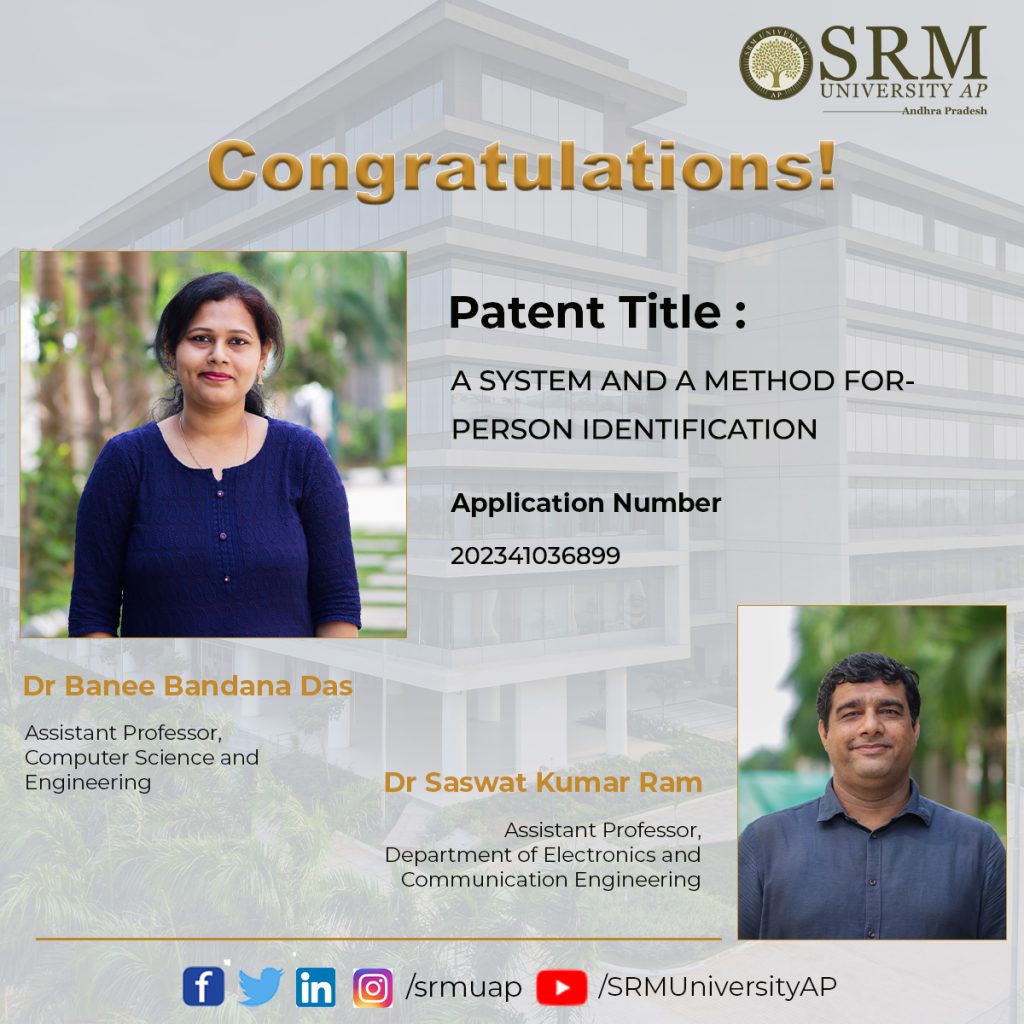
Today, biometric systems are widely used across all major domains, but alarmingly these systems are vulnerable to various security attacks. However, Dr Banee Bandana Das and Dr Saswat Kumar Ram, Assistant Professors at the Department of Computer Science and Engineering, SRM University-AP, have jointly come up with a solution that is more efficient and robust. The faculty duo have also filed and published the patent titled- “A System and A Method For Person Identification” with Application Number: 202341036899.
Abstract
Biometric representation of humans deal with tasks such as identification and verification. It can be done through various methods like fingerprint, face, retina, voice, etc. However, existing biometric systems are vulnerable to various security attacks. EEG-based biometrics are putting forward solutions because of their high-safety capabilities and handy transportable instruments. Motor imagery EEG (MI-EEG) is a broadly centred EEG signal exhibiting a subject’s motion intentions without actual actions. This invention proposes an unsupervised framework for feature learning based on autoencoders. It learns sparse feature representations for EEG-based person identification. Autoencoder-CNN exhibits the person identification task for signal reconstruction and recognition. The framework proved to be a practical approach in managing the massive volume of EEG data and identifying the person based on their different tasks in resting state. The experiments have been conducted on the standard publicly available Motor imagery EEG dataset with 109 subjects. This invention proposes an unsupervised framework for feature learning based on autoencoder to learn sparse feature representations for EEG-based person identification. Autoencoder and CNN do the person identification task for signal reconstruction and recognition. The outcomes imply that the implementation of an autoencoder-CNN architecture for person identification was intensely successful with improved recognition performance with the most notable autoencoder architecture. Eye open and closed resting state data as training data is used while four different motor imagery tasks have been considered test data in this biometric model. Training and testing of different state data of the same person have been proved to be the most robust and versatile EEG-based biometric system.
Practical Implementation of the Research
The present invention can be used in smart city applications, considering that the population of cities is increasing by the day, in which case, the security and privacy of people are at high risk in all sectors. The application of this technology will be in areas like:
Smart Office
The workflow and working efficiency of the employees can be enhanced with various innovative features and technology in an intelligent environment like smart offices of smart cities. Biometric-based methods involving fingerprints, retina, voice, and face recognition for secure authentication and identification of employees, clients, and different types of machinery are helpful. Various security attacks are the most severe issue related to these methods. Brain signals (EEG) are more secure and difficult to copy and steal, efficiently used for security needs and authentication.
Smart Healthcare
The laboratory and the data related to the health sectors are always important. The privacy and restricted access are must to secure it. By using the proposed invented model, the security can be enhanced as compared to the traditional biometric traits.
Smart Defence
The use of biometric in defence is not discussed in public but is undoubtedly an essential parameter in this domain. Many countries rely on biometric data like faces, irises, fingerprints, etc., for identification. A unique and trusted database is a must in defence for identifying persons involved in various operations. These include authenticating scientists, pilots, engineers etc., and to identify criminals in specific places. EEG-based person identification can be a secure alternative in this domain.
As a future prospect, Dr Das and Dr Ram are planning to develop a more secure and reliable biometric authentication system that will be based on Multimodal Techniques using Machine learning Methods.



